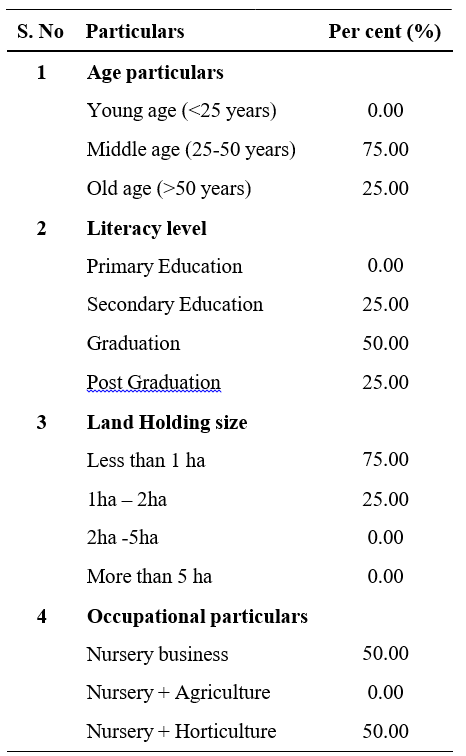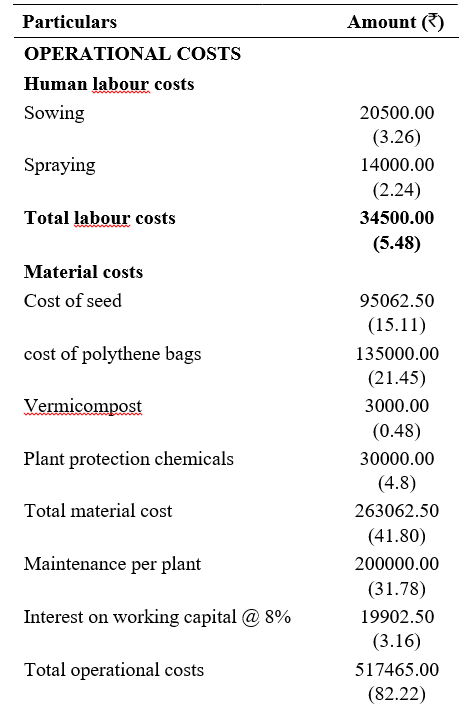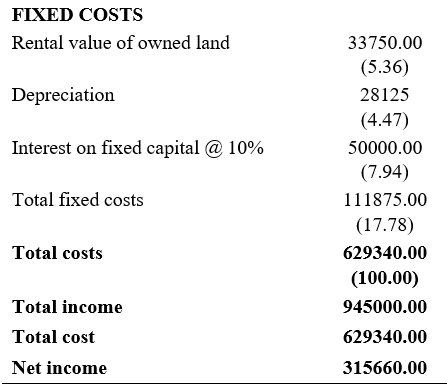Economic Analysis of Papaya Nurseries in Kadapa District of Andhra Pradesh – A Case Study
0 Views
R. DIVYA YADAV*, S. RAJESWARI, N.T. KRISHNA KISHORE AND B. RAMANA MURTHY
Institute of Agribusiness Management, S.V. Agricultural College, ANGRAU, Tirupati
ABSTRACT
The present study aimed to estimate the costs and returns and to know the financial viability of papaya nurseries in Kadapa district of Andhra Pradesh during 2020-21. The primary data was collected from papaya nursery entrepreneurs randomly with pretested questionnaire. To workout the costs and returns simple averages and percentages were employed. Discounted measures like NPV, BCR and IRR were used to know the financial viability of investment on papaya nurseries. The results indicated that the nursery entrepreneurs have incurred the total costs of ₹ 629340.00 for raising 1,00,000 saplings and realized net returns of ₹ 315660. Net present worth ₹ ( 2710765.55), benefit : cost ratio (1.34) and internal rate of return (21.84%) at 8 per cent discount rate, shows that the investment on papaya nursery was financially viable.
KEYWORDS: costs, economic analysis, financial feasibility, papaya nurseries, returns.
INTRODUCTION
Horticulture has become one of the major growth drivers of Indian economy as it is more income generative than the agricultural sector. It gives employment across the three sectors i.e. primary, secondary and tertiary. During 2019-20, Horticultural crops occupied an area of
26.47 million ha yielding about 320.77 million tonnes, with a total area under fruit cover in India at 6.76 million ha with 102.02 million tonnes production. India ranks second in the production of fruits and vegetables in the world, after China. Amongst fruits, India ranks first in the production of Bananas (26.08%), Papaya (44.05%) and Mangoes (45.89%). The cosmic production base offers India great opportunities for export. During 2020- 21, India exported Fruits worth of ‘ 4971.22 crores/674.53 USD millions. Fruits like mangoes, orange, grapes, bananas account to the major part of exports. The major destinations for fruits and vegetables are Bangladesh, UAE, Netherland, Nepal, Malaysia, UK, Sri Lanka, Oman and Qatar (Anonymous, 2020a).
The major problem faced by the growers of fruits and vegetables is the non-availability of true to type and healthy nursery plants. Most of the nurseries were still using traditional methods to raise the nursery plants. The quality and production of fruits and vegetables highly depends on the quality of nursery plants used. In this background the present study was carried out on
“Economic analysis of papaya nurseries in Kadapa district of Andhra Pradesh” with major objectives of estimating the costs and returns and evaluating the financial feasibility of papaya nurseries.
MATERIAL AND METHODS
Andhra Pradesh ranks first in papaya production in the country with 1.78 million tones (Anonymous, 2020a). Kadapa district was one of the leading producer of papaya with highest number of papaya nurseries in the state. Hence Kadapa district was purposively selected for the study. A total of 25 nurseries were sampled randomly for the study. A well structured questionnaire was used to collect the data from the nursery owners.
To calculate the costs and returns, simple arithmetic averages and percentages were worked out. Discounting techniques like Net Present Worth, Benefit-Cost ratio and Internal Rate of Return were employed to know the financial viability of papaya nurseries (Singh and Nandi, 2020).
RESULTS AND DISCUSSION
A perusal of Table 1 revealed that majority of the sample owners of papaya nurseries were belonged to age group of 25 to 50 years and 50 per cent of the sample nursery owners were graduated. 50 per cent of sample owner’s primary occupation was only nursery business
Table 1. Socio-economic profile of sample nursery

and the remaining 50 per cent were cultivating horticultural crops along with nursery business. The operational land holding data revealed that majority of farmers were having less than 1 ha.
Costs and Returns
Investment particulars of establishing papaya nurseries were presented in Table 2. Major costs incurred for establishing the papaya nursery was land costs which occupies 79.60 per cent followed by shade net costs (13.93%) and the remaining was for irrigation structures (6.46%). Thus, the total investment costs incurred for raising a papaya nursery was ₹5,12,500.
Table 2. Investment Particulars of papaya nurseries

On an average, 1,00,000 saplings were produced in a nursery for one cycle. Hence 1,00,000 saplings were taken as a unit for calculating costs and returns for the study. Costs of polythene bags account to ₹1,35,000 (21.45%). Vermi compost amounts to ₹ 3,000 (0.48%). Seed costs incurred to raise ₹1,00,000 papaya saplings was ₹95,062.50 (15.11%). Labour wages involved in sowing amounts to ₹20,500 (3.26%). Papaya is a highly sensitive crop; it is being attacked by various pests and diseases, so pesticides are to be used on a large scale. Cost of chemicals used for spraying valued to ₹30,000 (4.80%) which requires 20 man days. wages for spraying amounts to ₹14,000 (2.24%). Hence, total labour wages incurred was ₹ 34,500 (5.48%), total material costs amount to ₹2,63,062.50 (41.80%) and maintenance costs valued ₹2,00,000 (31.78%). Interest on working capital was ₹19,902.50 (3.16%). Therefore, the total operational costs are ₹5,17,465 (82.22%). Total fixed costs account to ₹1,11,875 (17.78%), which includes rental value of owned land at₹33,750 (5.36%), depreciation₹ 28,125 and interest on fixed capital was ₹50,000 (7.94%). Hence the total costs incurred in papaya nurseries were ₹6,29,340. (Table 3). From the results it was concluded that major costs in raising the papaya nurseries was maintenance cost, cost of polythenen bags and seed costs. Similar results were found by Majilinda (2012) in his study on economic analysis of fruit tree nurseries in Albania.
Out of the raised 1,00,000 saplings, the survival rate was only 70 per cent hence, the total returns obtained from selling papaya seedlings was 9,45,000 and the and the net returns are 3,15,660.
Table 3. Cost structure of papaya nurseries (per 1,00,000 papaya saplings)


Table 4. Financial viability of investments in papaya nurseries

Financial Viability of Papaya Nurseries
Financial viability of the investments on papaya nurseries were assessed by employing Net Present Worth, Benefit Cost Ratio and Internal Rate of Return and the results were present in Table 4. The net present worth of papaya nurseries was as high as ₹ 27,10,765.55, 19,33,864.13, ₹13,60,887.81 and ₹5,97,961.98 at ₹8, 10, 12 and 16 per cent discount rates respectively. The high positive net present value even at higher discount rates indicated the soundness of the investment made on Papaya nurseries. The benefit-cost ratio worked out to be 1.34, 1.28, 1.22 and 1.11 at 8, 10, 12 and 16 per cent discount rates respectively, indicating that at 8 per cent discount rate, each rupee of investment made in these nurseries would bring a net income of 0.34 on the papaya nurseries. These values proved that the investment on papaya nurseries was financially viable. These findings are in conformity with the findings reported by Ashoka et al. (2019) for investment in chilli nurseries.
The internal rate of return was found to be 21.48 per cent for papaya nurseries. The internal rate of returns was more than the bank rate of interest (15%) and hence nursery business was viable.
The net income obtained from each one cycle of Papaya seedlings production of 1,00,000 saplings was ‘ 315660. Further the discounted measures like NPV, BCR and IRR calculated for 30 years revealed that the papaya nurseries were financially viable at 8, 10, 12 and 16 per cent discount rate. This indicates the high profitability of the investments in papaya nurseries. But the major problem faced by the papaya nurseries was pests and disease infestation. Huge losses will incur during the periods of heavy infestation. Hence development of varieties resistant to pests and diseases was very important.
LITERATURE CITED
Anonymous. 2020a. https://apeda.gov.in/. Anonymous. 2020b. https://agricoop.nic.in.
Ashoka, N., Ravi, Y., Lingamurthy, K.R., Kumar, B.R and Anupama, G. 2019. A study on seedling demand and economic analysis of chilli nurseries in Karnataka. Journal of Crop and Weed. 15(2): 120-125.
Majilinda, C. 2012. Economic analysis of fruit tree nurseries in Albania. Agro – Knowledge Journal. 13: 67 – 72.
Singh, S.P and Nandi A.K. 2020. A Financial viability and relative profitability of mango orcharding in Lucknow district of Uttar Pradesh. Economic Affairs. 65(1): 77-83.
- Genetic Divergence Studies for Yield and Its Component Traits in Groundnut (Arachis Hypogaea L.)
- Correlation and Path Coefficient Analysis Among Early Clones Of Sugarcane (Saccharum Spp.)
- Character Association and Path Coefficient Analysis in Tomato (Solanum Lycopersicum L.)
- Survey on the Incidence of Sesame Leafhopper and Phyllody in Major Growing Districts of Southern Zone of Andhra Pradesh, India
- Effect of Organic Manures, Chemical and Biofertilizers on Potassium Use Efficiency in Groundnut
- A Study on Growth Pattern of Red Chilli in India and Andhra Pradesh

